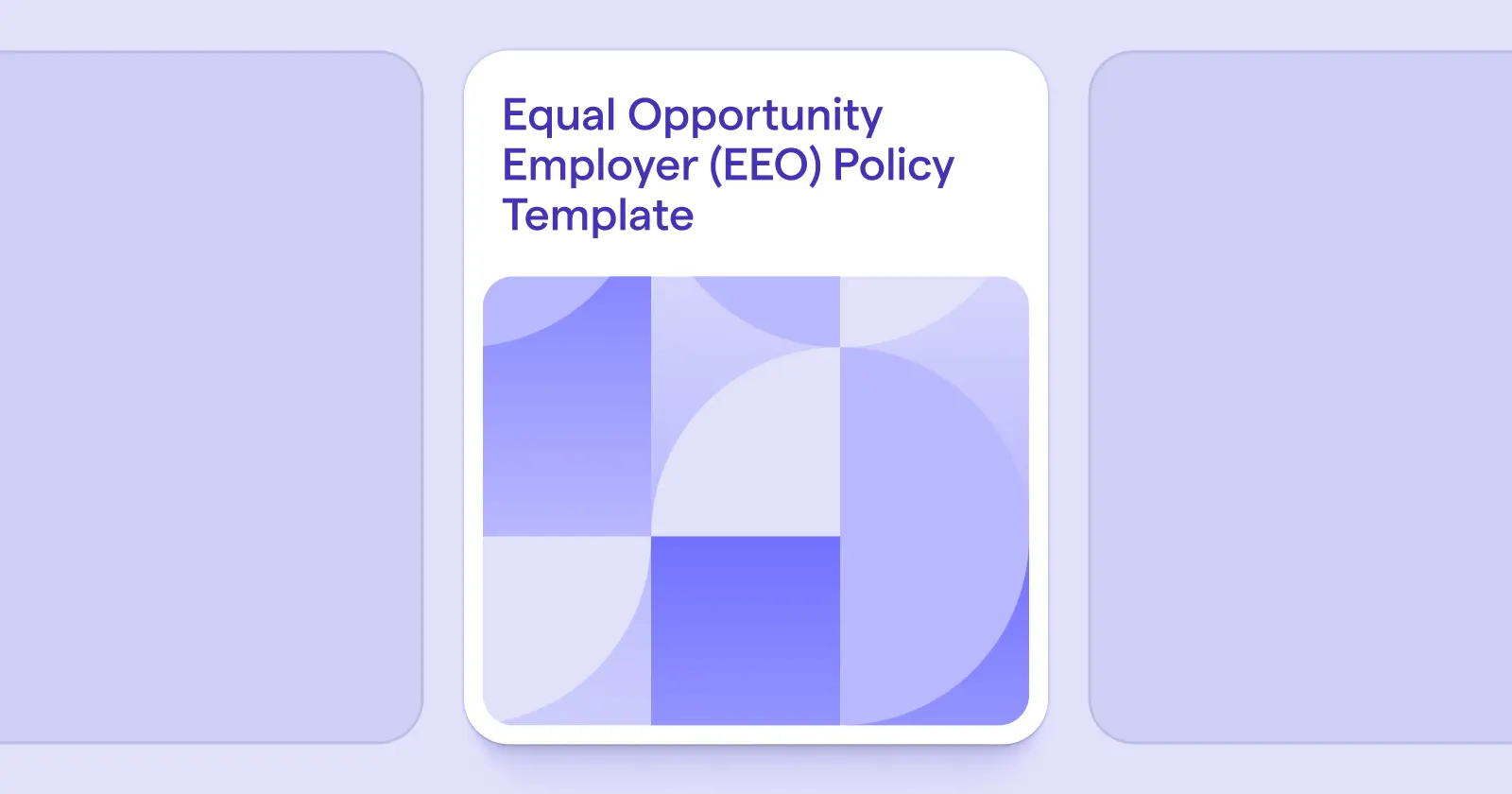Equal Opportunity Employer (EEO) Policy Template

Download this template for free
By submitting your information, you agree to Lattice's Terms of Service and Privacy Policy. You can opt out anytime.
Thanks! We'll be in touch soon.
Creating a workplace where everyone has a fair chance to succeed isn’t just good business — it’s the right thing to do. A clear and consistent Equal Opportunity Employer (EEO) policy helps ensure that every employment decision is made based on qualifications, performance, and potential — not bias, assumptions, or exclusion.
This policy outlines your company’s commitment to equal employment opportunity and explains how that commitment applies to hiring, promotions, compensation, training, and more. It also ensures compliance with applicable federal, state, and local anti-discrimination laws.
What the EEO Policy Should Include
To be complete and actionable, your EEO policy should outline:
- Purpose and scope: Why the policy exists and who it applies to
- Protected characteristics: A full list of the traits protected by law (e.g., race, gender, disability)
- Employment practices covered: Hiring, compensation, promotions, training, terminations, etc.
- Company responsibilities: How leaders and HR uphold the policy
- Reporting and enforcement: How employees can report discrimination and what happens next
- Anti-retaliation statement: Assurance that employees won’t be punished for reporting concerns
- Compliance with the law: Reference to EEOC, ADA, and other relevant laws and regulations
- Commitment to diversity, equity, inclusion, and belonging: (Optional) How the policy supports broader DEIB efforts
Purpose of the Equal Opportunity Policy
This policy is designed to:
- Ensure that employment decisions are based on merit, qualifications, and organizational needs
- Prevent discrimination and harassment in all aspects of employment
- Promote a workplace culture where every employee feels safe, respected, and empowered
- Comply with all applicable federal, state, and local anti-discrimination laws
Equal opportunity is not just a legal requirement — it’s a reflection of the values we want to live by.
Sample Equal Opportunity Employer Policy
{{rich-highlight-1}}
Effective Date: [Insert Date]
Policy Owner: People Team / Legal / HR Department
Last Reviewed: [Insert Date]
1. Policy Overview
[Company Name] is proud to be an Equal Opportunity Employer. We are committed to providing a work environment that is free from discrimination and harassment. All employment decisions are made without regard to legally protected characteristics and are based on business needs, job requirements, and individual qualifications.
This policy applies to all aspects of employment, including recruitment, hiring, compensation, promotion, transfer, training, layoff, recall, and termination.
2. Protected Characteristics
We prohibit discrimination based on (but not limited to) the following protected characteristics:
- Race, color, or ethnicity
- National origin or ancestry
- Sex, gender, or gender identity
- Sexual orientation
- Religion or creed
- Age
- Marital or family status
- Pregnancy or related medical conditions
- Disability (physical or mental)
- Veteran status or military service
- Genetic information
- Any other status protected by applicable federal, state, or local law
We also provide reasonable accommodations for qualified individuals with disabilities and for sincerely held religious beliefs, unless doing so would create an undue hardship.
3. Employment Practices
Equal opportunity applies to all employment decisions, including:
- Recruitment, job postings, and applicant selection
- Offers of employment and onboarding
- Assignment of duties and access to opportunities
- Performance evaluations and feedback
- Compensation, benefits, and advancement
- Disciplinary actions and terminations
Every employee, especially those involved in hiring or management, is expected to act in accordance with this policy and help ensure a workplace free from discrimination or bias.
4. Reporting and Resolution
If you believe you have experienced or witnessed discrimination, harassment, or retaliation, you are strongly encouraged to report it to:
- Your manager or supervisor
- The People Team / HR
- [Insert reporting system or anonymous hotline]
All reports will be taken seriously and investigated promptly. We will take appropriate action based on the findings and in accordance with applicable law and internal policy.
{{rich-highlight-3}}
5. No Retaliation
We strictly prohibit retaliation against anyone who:
- Reports a suspected violation of this policy
- Participates in a discrimination investigation or grievance process
- Requests an accommodation for a disability or religious practice
If you believe you’ve experienced retaliation, report it immediately. Any employee found to have retaliated against another will be subject to disciplinary action, up to and including termination.
6. Legal Compliance
This policy is designed to comply with:
- Title VII of the Civil Rights Act of 1964
- The Americans with Disabilities Act (ADA)
- The Age Discrimination in Employment Act (ADEA)
- The Equal Pay Act
- The Genetic Information Nondiscrimination Act (GINA)
- All other relevant federal, state, and local anti-discrimination laws
We regularly review this policy to ensure it reflects current legal standards and best practices.
7. Commitment to Inclusion
Beyond legal compliance, we believe in building an inclusive workplace where everyone can thrive. This means creating processes that promote equity, elevating underrepresented voices, and embedding belonging into our culture and systems.
We know that equal opportunity is the floor — not the ceiling — and we are committed to going beyond compliance in the way we build, lead, and grow our teams.
Frequently Asked Questions
1. Who does this policy protect?
Everyone. The policy applies to all employees, job applicants, contractors, and anyone involved in our hiring or management processes.
2. What’s the difference between discrimination and harassment?
Discrimination involves unfair treatment based on protected characteristics. Harassment includes unwelcome behavior (verbal or physical) that creates a hostile, intimidating, or offensive work environment.
3. How do I request an accommodation for a disability or religious belief?
Contact HR. We’ll work with you confidentially to explore reasonable accommodations that support your needs while meeting business requirements.
4. What happens after I report discrimination?
HR or an assigned investigator will follow up promptly. We’ll gather information, keep the process as confidential as possible, and communicate the outcome to those involved.
5. Can I be fired for reporting something?
No. Retaliation is strictly prohibited under this policy and by law. If you feel you’ve been treated unfairly for speaking up, let us know immediately.
{{rich-highlight-2}}
🚩 Please note: This sample policy is for informational purposes only and does not constitute legal advice. It may not suit your specific organization or local laws. When adopting or revising a policy, consult legal counsel to ensure full compliance.
✨ Disclaimer: This resource was developed with the help of artificial intelligence, though reviewed, edited, and approved by (real) humans.
Frequently Asked Questions

Your people are your business
Ensure both are successful with Lattice.




.webp)